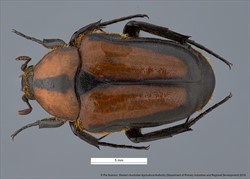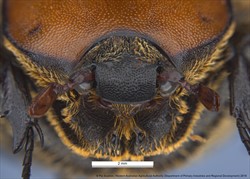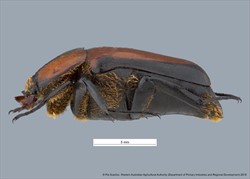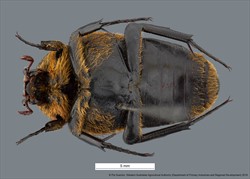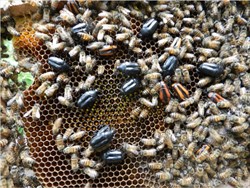Sub family: Cetoniinae / Tribe: Chremastocheilini / Genus: Oplostomus
Fact Sheet
Oplostomus haroldi (Witte, 1880)
Large, broad beetles, body length: 29-22mm length, body colour: black, shiny, with varying red to yellow/orange stripes usually present. Complete black forms have also been reported. Red/orange antennal segments. Ventral body surface with a dense coverage of bright orange setae on areas of the prosternum, metasternum, femurs and final sternites, and dorsally on the mesepimeron. Antennae 10-segmented, with a 3-segmented club. Clypeus with a subquadrate apex. Pronotum smooth with even covering of shallow punctations. Mesepimeron partially visible anterior to elytral shoulders. Scutellum large, triangular, pointed at apex. Elytra with raised areas on apical half, flanked by depressions of punctated/striated area. Metasternum projecting between bases of mesocoxae, seamlessly continuing through to mesosternum, but without a forward protruding process.
Oplostomus haroldi, also known as a form of the Large Hive Beetle or Large African Hive Beetle (LAHB), is a recognised pest of honeybee (Apis mellifera) hives. Adult beetles invade colonies to feed on young bee brood, stored pollen and honey. Severe infestations of hundreds of beetles per hive have been recorded. Their feeding can potentially lead to the death of the colony. Adult beetles can live for multiple months under laboratory conditions.
Larvae live in the soil and feed on animal (cattle or horse) dung and compost.
Any potential sightings of Oplostomus in Australia should be immediately reported to your local department of Agriculture.
Oplostomus are African in origin, and absent from Australia. O. haroldi is known from Tanzania, Kenya and South Africa, but is thought to be widespread across all of sub-Saharan Africa.
Oplostomus haroldi and fuligenus are thought to prefer slightly different climates, with O. haroldi more prevalent in wetter coastal areas, and O. fuligeneus in dryer grazing land.
Fombong, A.T., Haas, F., Ddegwa, P.N., Irungu, L.W. 2012. Life history of Oplostomus haroldi (Coleoptera: Scarabaeidae) under laboratory conditions and a description of its third larval instar, International Journal of Tropical Insect Science 32(01): 1-8 doi:10.1017/S1742758412000021
Wambua, B., Muli, E., Kilonzo, J., Ng’ang’a, J., Kanui, T., Muli, B. 2019. Large Hive Beetles: An Emerging Serious Honey Bee Pest in the Coastal Highlands of Kenya, Bee World, 96(3): 1-2 DOI: 10.1080/0005772X.2019.1568355

